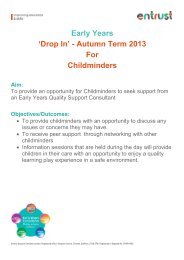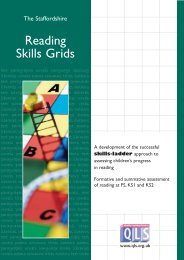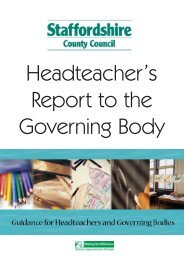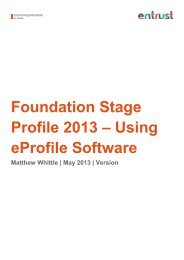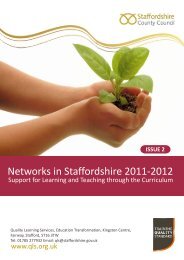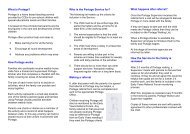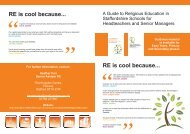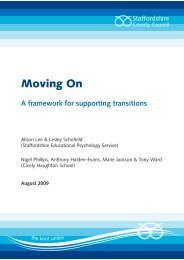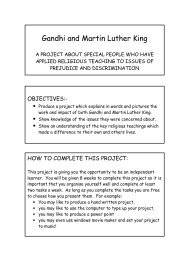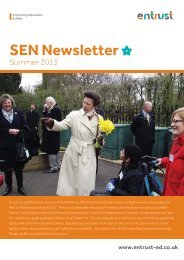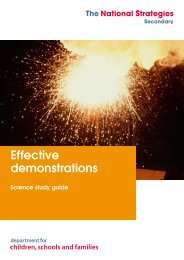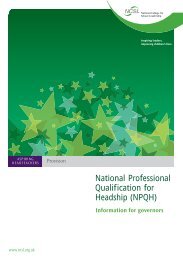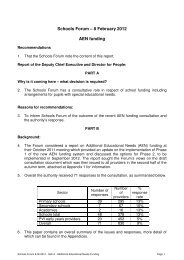Framework for teaching modern foreign languages: Years 7, 8 and 9
Framework for teaching modern foreign languages: Years 7, 8 and 9
Framework for teaching modern foreign languages: Years 7, 8 and 9
Create successful ePaper yourself
Turn your PDF publications into a flip-book with our unique Google optimized e-Paper software.
Key Stage 3<br />
National Strategy<br />
<strong>Framework</strong> <strong>for</strong> <strong>teaching</strong> <strong>modern</strong> <strong>for</strong>eign <strong>languages</strong>:<br />
<strong>Years</strong> 7, 8 <strong>and</strong> 9
2<br />
<strong>Framework</strong> <strong>for</strong> <strong>teaching</strong> <strong>modern</strong> <strong>for</strong>eign <strong>languages</strong>: <strong>Years</strong> 7, 8 <strong>and</strong> 9 © Crown copyright 2003
Contents<br />
Foreword 5<br />
Executive summary 7<br />
Section 1 About the MFL <strong>Framework</strong><br />
Introduction 11<br />
What is the Foundation Subjects str<strong>and</strong> of the Key Stage 3 National Strategy? 12<br />
What is the Key Stage 3 MFL <strong>Framework</strong> <strong>and</strong> what is it <strong>for</strong>? 13<br />
How is the <strong>Framework</strong> of objectives structured? 14<br />
Why is there one framework to cover different <strong>languages</strong>? 15<br />
What is the thinking behind the MFL <strong>Framework</strong>? 15<br />
What are the general principles about language <strong>teaching</strong> <strong>and</strong> learning behind 16<br />
the MFL <strong>Framework</strong>?<br />
How does the MFL <strong>Framework</strong> relate to the National Curriculum programme 18<br />
of study <strong>and</strong> the QCA schemes of work?<br />
What is the thinking behind the <strong>Framework</strong> objectives? 22<br />
How are we meant to use the <strong>Framework</strong> of objectives? 25<br />
How do we set about <strong>teaching</strong> with the MFL <strong>Framework</strong> <strong>and</strong> what about the use 26<br />
of the target language in the classroom?<br />
Is the MFL <strong>Framework</strong> only <strong>for</strong> use with the first <strong>for</strong>eign language taught at Key Stage 3? 26<br />
How do we use the MFL <strong>Framework</strong> with pupils of different abilities? 26<br />
It all looks quite challenging. How do we implement the MFL <strong>Framework</strong>? 31<br />
Section 2 <strong>Framework</strong> of objectives<br />
a Teaching objectives by year 36<br />
b Teaching objectives by str<strong>and</strong> 39<br />
c Teaching objectives with examples 44<br />
Section 3 Appendices<br />
1 From <strong>Framework</strong> to classroom 63<br />
2 Name tags 80<br />
3 High-frequency words 84<br />
4 Glossary of terms 105<br />
© Crown copyright 2003 <strong>Framework</strong> <strong>for</strong> <strong>teaching</strong> <strong>modern</strong> <strong>for</strong>eign <strong>languages</strong>: <strong>Years</strong> 7, 8 <strong>and</strong> 9 3
Section 4 Additional guidance on inclusion<br />
Inclusion 139<br />
Including pupils with special educational needs (SEN) <strong>and</strong> disabilities 140<br />
Pupils learning English as an additional language (EAL) 145<br />
Supporting <strong>and</strong> challenging gifted <strong>and</strong> talented pupils 149<br />
Gender <strong>and</strong> achievement in MFL 150<br />
MFL <strong>and</strong> ICT 151<br />
4<br />
<strong>Framework</strong> <strong>for</strong> <strong>teaching</strong> <strong>modern</strong> <strong>for</strong>eign <strong>languages</strong>: <strong>Years</strong> 7, 8 <strong>and</strong> 9 © Crown copyright 2003
Foreword<br />
Learning <strong>for</strong>eign <strong>languages</strong> is increasingly important in a global economy <strong>and</strong> also has great value in<br />
terms of cultural <strong>and</strong> linguistic richness in our society, personal fulfilment <strong>and</strong> global citizenship <strong>and</strong><br />
underst<strong>and</strong>ing. This <strong>Framework</strong> <strong>for</strong> <strong>teaching</strong> <strong>modern</strong> <strong>for</strong>eign <strong>languages</strong> underscores the vital importance<br />
of giving all pupils the tools to make direct <strong>and</strong> personal contact with other people <strong>and</strong> their cultures. The<br />
<strong>Framework</strong> <strong>and</strong> its associated training programme support our National Languages Strategy <strong>and</strong> will help<br />
to create language learners.<br />
The <strong>Framework</strong> is deliberately similar to the National Literacy Strategy <strong>and</strong> the Key Stage 3 English<br />
<strong>Framework</strong>s <strong>and</strong> attempts to build on the linguistic skills which pupils bring with them to the study of a<br />
<strong>modern</strong> language. A key feature of the Foundation Subjects str<strong>and</strong> is the emphasis it gives to the<br />
<strong>teaching</strong> of thinking skills <strong>and</strong> to assessment <strong>for</strong> learning. These help pupils to reach higher levels of<br />
attainment <strong>and</strong> become independent learners.<br />
The <strong>Framework</strong> draws upon best practice in the schools taking part in the Pilot programme <strong>and</strong> teachers<br />
have made an important contribution to the <strong>Framework</strong> <strong>and</strong> training materials. The training programme<br />
fully reflects the integral place of MFL within the Foundation Subjects str<strong>and</strong> of the Key Stage 3 Strategy<br />
<strong>and</strong> offers teachers of MFL an opportunity to focus collaboratively on the same range of <strong>teaching</strong> <strong>and</strong><br />
learning strategies as their colleagues in other Foundation Subjects. I hope teachers of MFL will find the<br />
<strong>Framework</strong> a valuable resource in motivating all pupils to be enthusiastic learners of <strong>modern</strong> <strong>for</strong>eign<br />
<strong>languages</strong>.<br />
Catherine Ashton, Parliamentary Under Secretary of State <strong>for</strong> Sure Start <strong>and</strong> School St<strong>and</strong>ards<br />
© Crown copyright 2003 <strong>Framework</strong> <strong>for</strong> <strong>teaching</strong> <strong>modern</strong> <strong>for</strong>eign <strong>languages</strong>: <strong>Years</strong> 7, 8 <strong>and</strong> 9 5
6<br />
<strong>Framework</strong> <strong>for</strong> <strong>teaching</strong> <strong>modern</strong> <strong>for</strong>eign <strong>languages</strong>: <strong>Years</strong> 7, 8 <strong>and</strong> 9 © Crown copyright 2003
Executive summary<br />
The <strong>Framework</strong> <strong>for</strong> <strong>teaching</strong> <strong>modern</strong> <strong>for</strong>eign <strong>languages</strong>: <strong>Years</strong> 7, 8 <strong>and</strong> 9 is a progressive set of <strong>teaching</strong><br />
objectives <strong>for</strong> MFL. It is based on the Key Stage 3 programme of study <strong>and</strong> draws on good practice in the<br />
<strong>teaching</strong> of MFL. The objectives can be applied to any language, but examples are given in French,<br />
German <strong>and</strong> Spanish as these are the ones most commonly taught.<br />
The <strong>Framework</strong> is about learning <strong>languages</strong> <strong>and</strong> also about creating confident language learners,<br />
equipped with the skills <strong>and</strong> conventions of language learning. With this confidence <strong>and</strong> underst<strong>and</strong>ing,<br />
pupils should be well placed to learn other <strong>languages</strong> later.<br />
Section 1: About the MFL <strong>Framework</strong><br />
This section puts MFL within the Key Stage 3 Strategy <strong>and</strong> the Foundation Subjects str<strong>and</strong>. It explains the<br />
thinking behind the <strong>Framework</strong>, the way it is organised <strong>and</strong> how it can be used. It also contains guidance<br />
on matching work to different learning needs.<br />
Section 2: <strong>Framework</strong> of objectives<br />
This section contains objectives set out year on year under the following five headings:<br />
• Words<br />
• Sentences<br />
• Texts: reading <strong>and</strong> writing<br />
• Listening <strong>and</strong> speaking<br />
• Cultural knowledge <strong>and</strong> contact.<br />
This structure draws on <strong>and</strong> extends the word-, sentence- <strong>and</strong> text-level organisation of the frameworks<br />
<strong>for</strong> the National Literacy Strategy <strong>and</strong> English at Key Stage 3.<br />
Each yearly set of objectives has a distinct emphasis:<br />
• In Year 7, pupils receive a firm foundation in what will be <strong>for</strong> most their first year of <strong>for</strong>eign language<br />
learning.<br />
• In Year 8, the objectives reflect this secure start <strong>and</strong> promote acceleration in language acquisition.<br />
• In Year 9, the objectives are designed to promote pupils’ independence as language learners.<br />
Within this overall intent, there is scope <strong>for</strong> variation. For example, some Year 7 pupils may already be<br />
working on objectives from Year 8, while others may continue with the Year 7 objectives <strong>for</strong> longer than<br />
one year. What matters is the laying of a firm foundation <strong>for</strong> later language development.<br />
© Crown copyright 2003 <strong>Framework</strong> <strong>for</strong> <strong>teaching</strong> <strong>modern</strong> <strong>for</strong>eign <strong>languages</strong>: <strong>Years</strong> 7, 8 <strong>and</strong> 9 7
Section 3: Appendices<br />
1 From <strong>Framework</strong> to classroom<br />
This appendix sets out a detailed demonstration of how a teacher might plan to teach the <strong>Framework</strong><br />
objectives over the long <strong>and</strong> medium term <strong>and</strong> at lesson level, based on an existing scheme of work.<br />
2 Name tags<br />
Name tags are the objectives in abbreviated <strong>for</strong>m <strong>and</strong> are a quick <strong>and</strong> convenient means of reference.<br />
3 High-frequency words<br />
Lists of high-frequency words in French, German <strong>and</strong> Spanish are provided. Work on these words allows<br />
pupils to do more with the vocabulary they have at their comm<strong>and</strong>.<br />
4 Glossary of terms<br />
This is an amended version of the glossary provided <strong>for</strong> the National Literacy Strategy. It offers a common<br />
terminology <strong>for</strong> discussion about language <strong>and</strong> in<strong>for</strong>ms teachers of MFL about the terminology which<br />
pupils are taught to use in primary literacy <strong>and</strong> in Key Stage 3 English.<br />
Section 4: Additional guidance on inclusion<br />
This section contains general guidance similar to that found in previous frameworks on ensuring access<br />
to the MFL curriculum <strong>for</strong> a wide range of pupils.<br />
8<br />
<strong>Framework</strong> <strong>for</strong> <strong>teaching</strong> <strong>modern</strong> <strong>for</strong>eign <strong>languages</strong>: <strong>Years</strong> 7, 8 <strong>and</strong> 9 © Crown copyright 2003



